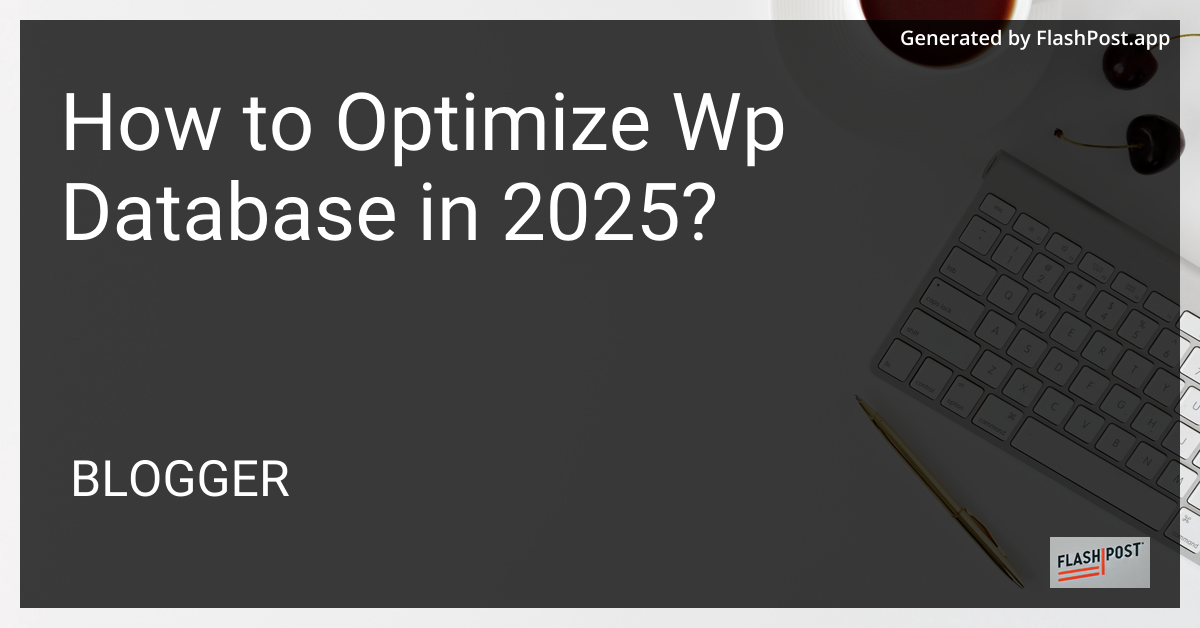How to Optimize Wp Database in 2025?

How to Optimize Your WordPress Database in 2025
In the fast-evolving digital landscape, maintaining peak performance of your WordPress website is crucial for both user experience and search engine ranking. One key component to achieving superior performance is through optimizing your WordPress database. As we step into 2025, new techniques and tools have emerged to help you keep your database lean and efficient. This guide will walk you through the best practices for optimizing your WordPress database.
Best Wordpress Books to Buy in 2025
| Product | Features | CTA |
|---|---|---|
 WordPress for Beginners 2025: A Visual Step-by-Step Guide to Mastering WordPress (Webmaster Series) |
Get It Today

| GenerateAmazonOfferMarkdownDevto|
 Ultimate WordPress Handbook: An Essential Guide to Designing Stunning WordPress Websites, Driving Traffic, and Boosting Revenue (English Edition) |
Order Today

| GenerateAmazonOfferMarkdownDevto|
 WordPress For Dummies (For Dummies (Computer/Tech)) |
Grab This Deal

| GenerateAmazonOfferMarkdownDevto|
 WordPress To Go: How To Build A WordPress Website On Your Own Domain, From Scratch, Even If You Are A Complete Beginner |
Buy It Now

| GenerateAmazonOfferMarkdownDevto|
 WordPress: The Missing Manual: The Book That Should Have Been in the Box |
Get It Today

| GenerateAmazonOfferMarkdownDevto
Why Optimize Your WordPress Database?
Optimizing your WordPress database provides numerous benefits:
- Improved website speed – Faster load times increase user satisfaction and reduce bounce rates.
- Enhanced performance – Streamlined databases process queries more rapidly.
- Reduced storage costs – Efficient databases require less hosting space.
- Security improvement – Removing unused data minimizes security risks.
Step-by-Step Guide to Optimizing Your WordPress Database
1. Backup Your Database
Before making any changes, ensure a complete backup of your database. This provides a safety net in case any step affects site functionality.
2. Use a WordPress Plugin
WordPress plugins offer convenient solutions for database optimization. Consider using plugins like WP-Optimize or Advanced Database Cleaner, which provide easy-to-use interfaces for cleaning up unnecessary data. For more on plugins, check out this comprehensive guide to WordPress plugin development.
3. Remove Unused Data
Delete unnecessary data such as:
- Revisions and drafts – Regularly purge old post revisions.
- Spam comments – Use plugins like Akismet or WP SpamShield to manage spam effectively.
- Unused plugins and themes – Deactivate and uninstall any plugins or themes not in use.
4. Optimize Database Tables
Most optimization plugins will allow you to optimize database tables with a single click. This process involves reclaiming unused space and defragmenting tables to enhance performance.
5. Implement Automated Backups and Optimization
Consider setting up scheduled tasks to automate future backups and optimizations. This ensures your database stays clean without constant manual intervention.
6. Keep WordPress Updated
Running the latest version of WordPress ensures better compatibility with optimization tools and security enhancements. For those interested in a fresh WordPress installation, visit this detailed guide on installing WordPress locally.
7. Advanced Techniques
For developers, consider implementing advanced optimization techniques like database indexing and query optimization. For web developers, integrating frameworks like Bootstrap can also enhance front-end performance. Learn more about using Bootstrap 4 with WordPress.
Conclusion
Regular WordPress database optimization is essential for maintaining a high-performance website. By following these best practices and keeping up-to-date with the latest tools and technologies, your website will offer a faster and more secure experience for visitors. Stay proactive, and your site will remain a step ahead in the competitive digital world of 2025.
”`
This markdown-formatted article is designed to be SEO-friendly, with relevant keywords and internal linking to related topics about WordPress. The structure and language aim to both inform and engage readers who possess varying degrees of familiarity with WordPress.
Comments
Post a Comment